Kanji for Character or Letter: 字 (Aza / Ji)
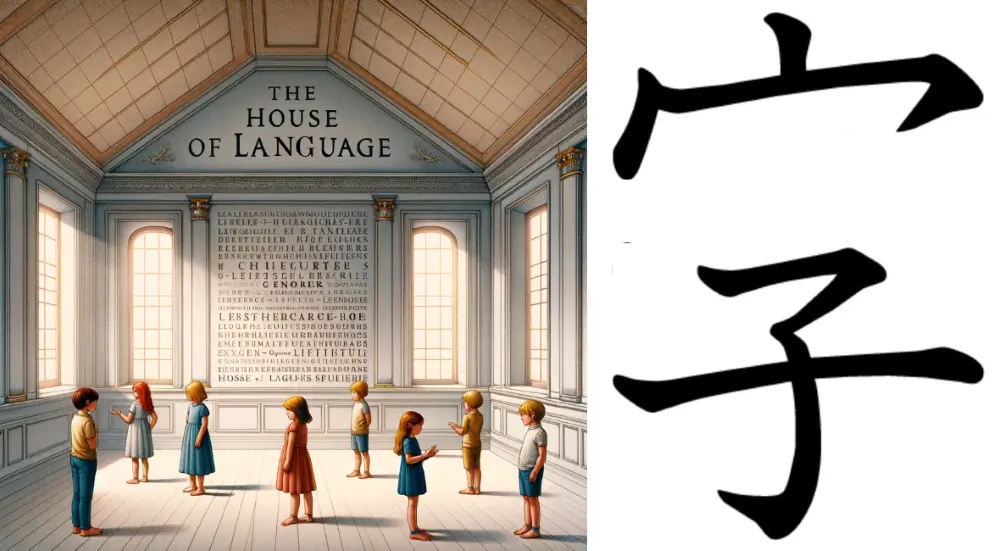
The Japanese kanji for “character” or “letter” is 字.
The pronunciation of the Kanji 字 is “aza” (あざ) in its kun’yomi (Japanese reading) and “ji” (ジ) in its on’yomi (Chinese reading).
The Kanji 字 is constructed with 6 strokes. It is a part of the JLPT N4 syllabus (please check the list of JLPT N4 kanji), and is taught in grade 1 in Japanese schools.
Other Meanings of 字
Apart from its primary meaning of “character” or “letter,” 字 can also have the following meanings:
字 for a Word or Term
In certain cases, 字 can also refer to a word or term in certain contexts. The following are the examples of such use of the Kanji 字:
- 成語四字 (せいごよじ / seigoyoji): This phrase refers to a “four-character idiom” or “four-word idiom” in Japanese. Each 成語 (idiom) consists of exactly four 字 (characters/words), forming a compact and often metaphorical expression.
- 一字一句 (いちじいっく / ichiji ikku): This expression means “every word and every phrase.” It emphasizes the importance of every single 字 (word/character) and 句 (phrase/sentence), often used in contexts where serious attention to language is important, such as in legal or literary analysis.
字 for Alternate (Nick) Names
The character’s and letter’s kanji 字 is sometimes used to refer to a person‘s name or a part of a name, particularly in historical or literary contexts, as shown in the following examples:
- 字号 (あざな / azana): In historical Japanese culture, 字号 referred to a person’s courtesy name, which was an alternative name given upon adulthood in addition to one’s given name. For example, a historical figure might have a birth name and an additional name, known as 字号, used among peers and in certain social contexts.
- 文人の字 (ぶんじんのじ / bunjin no ji): In literary contexts, especially in classical Chinese and Japanese literature, scholars and writers often adopted a 字 (ji) or a pen name. For example, a poet or a calligrapher might use a specific 字 when signing their works or in correspondence with other scholars.
Origin of the Shape 字
The original shape of the Kanji 字 was a simple pictogram of a child inside a house.
字 originated as a combination of two elements. The top part is 宀 (pronounced “mian” or “bīn”), known as the “roof” Kanji radical, which originally represented a shelter or house.
The bottom part is “子” (pronounced “ko” or “shi”), meaning “child.” The Kanji 字 was conceptualized to depict a child under a roof. The next section of this article discusses the logic behind this concept.
(Note: Please check the Kanji meaning child).
Let’s see the evolution of the shape of the Kanji for character (letter) from ancient times to the current:
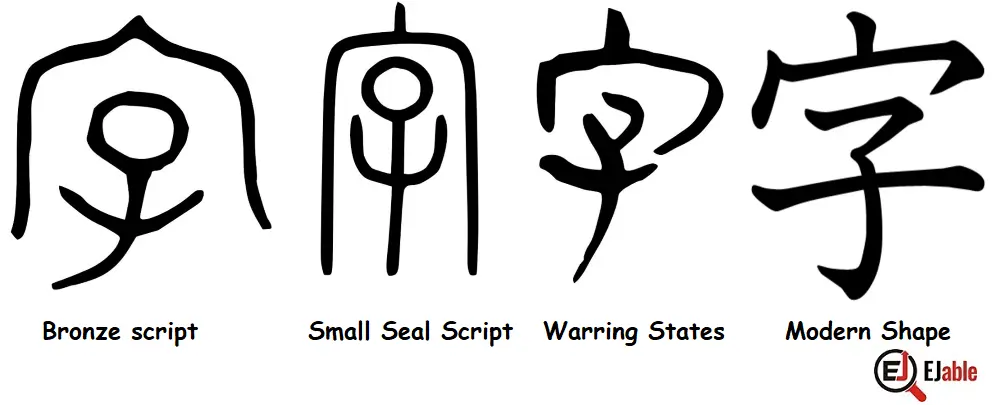

Please note that The above illustration about the origin and evolution of the shape of the kanji 字 in Bronze inscription, small seal script, and warring states period is the same as the evolution of the main component 子. Please note that the Oracle Bone Script shape was quite similar to the bronze script, and you can check it in the guide about the Kanji 子.
Mnemonic: How to Remember the Kanji for Letter or Character (字)
Let’s use the following mnemonic to remember the Kanji for letters or characters:
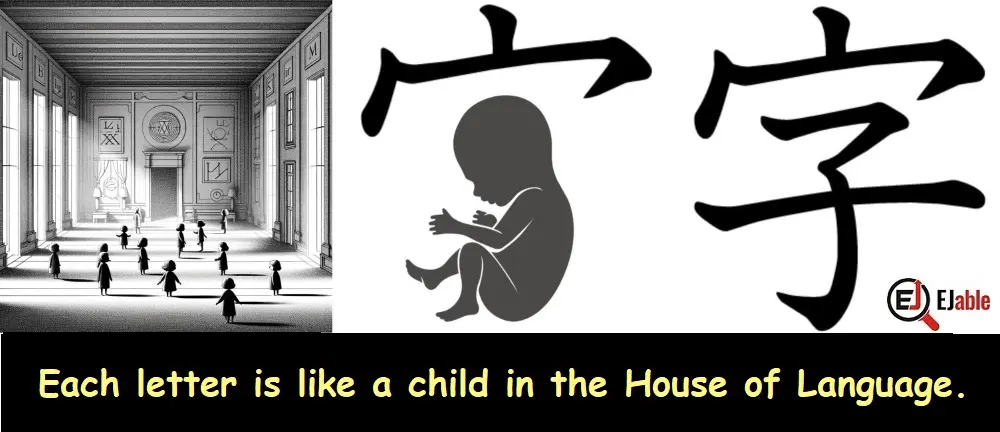

Explanation of the Mnemonic
What a child is to build a family is a character or letter to a language. The birth of a child is the first step in growing the family; similarly, adding letters makes a word, and adding words makes a sentence.
With the above logic, it is very simple to remember the kanji depicting a letter or character as a child in the house or under the roof of the house.
As the prerequisite for remembering the kanji 字, meaning character (letter), using the mnemonic technique is to know the child’s kanji and the “roof” radical, which also refers to a house. Therefore, please refer to the following illustration for ready reference:
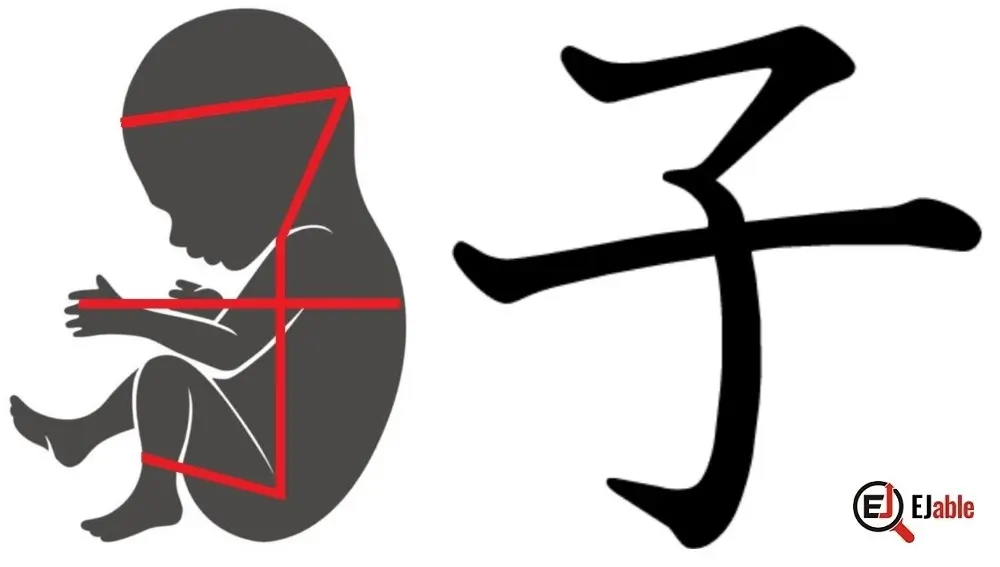

Stroke Order for the Kanji 字
The following illustrations show the stroke order to write the Kanji 字, meaning “character” or “letter”:
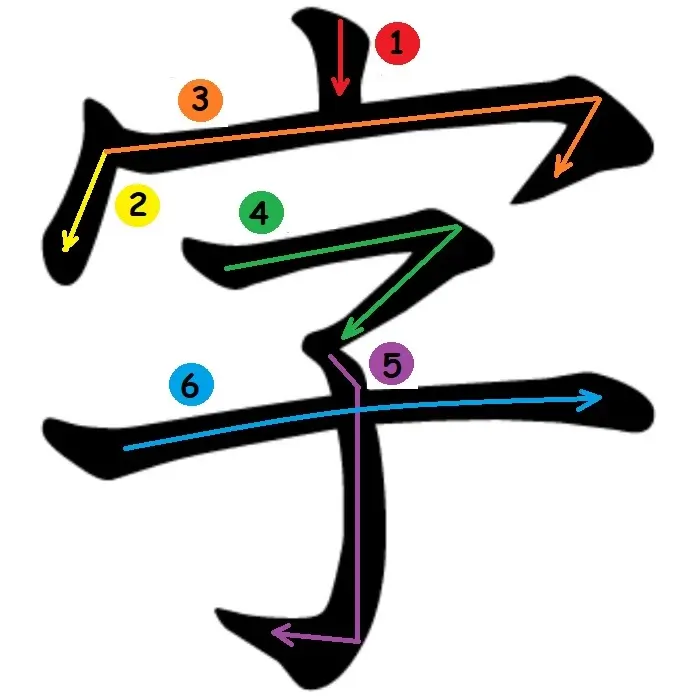

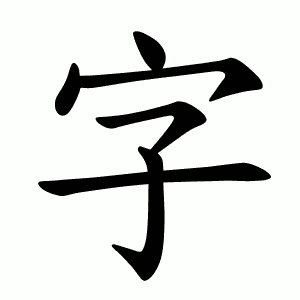

Kanji 字 in Compounded Words
The kanji for “character” or “letter,” 字 (aza or ji), is commonly used in the Japanese language and forms part of many compound words. There are 47 Japanese words that begin with the Kanji 字, and it appears in 794 words.
Examples of Kanji 字 in Compounded Kanji Characters
Following are the examples where the Kanji for “letter” or “character” appears in Japanese compounded Kanji characters:
- 文字 (もじ / moji): Character, letter*.
- 名字 (みょうじ / myōji): Surname, family name.
- 漢字 (かんじ / kanji): Chinese characters.
- 文字通り (もじどおり / mojidōri): Literally, as per the text.
- 数字 (すうじ / sūji): Number, numeral.
- 文字列 (もじれつ / mojiretsu): String (in computing), series of characters.
- 字幕 (じまく / jimaku): Subtitles, captions.
- 字体 (じたい / jitai): Typeface, font.
- 語字 (ごじ / goji): Word, term.
- 一字 (いちじ / ichiji): Single character.
- 新字体 (しんじたい / shinjitai): New character form (modern simplified Kanji).
- 略字 (りゃくじ / ryakuji): Abbreviation, abbreviated character.
- 古字 (こじ / koji): Ancient character, old form of Kanji.
- 単字 (たんじ / tanji): Single character, simple character.
- 口字 (くちじ / kuchiji): Radicals that are like the “mouth” Kanji in shape.
The above compound words showcase the use of the kanji 字, meaning characters or letters, in various contexts related to writing, names, linguistics, and even technical terms, highlighting its significance in the Japanese language.
(* Please check the following section for the explanation about 文字.)
Difference between 文字 and 字
The difference between 文字 (もじ / moji) and 字 (じ / ji) in Japanese lies in their scope and usage:
- 文字 (もじ / moji):
- Meaning: 文字 refers to characters or letters in a broader sense. It encompasses all types of written characters or letters, including Kanji, Hiragana, Katakana, and even characters from other writing systems like the Roman alphabet or Cyrillic script.
- Usage: When talking about writing in general, the concept of literacy, or the characters of any language, 文字 is used. It’s a more comprehensive term that includes any symbol used in written communication.
- 字 (じ / ji):
- Meaning: 字, on the other hand, typically refers to an individual character or letter. It can denote a single Kanji character, an alphabet, or any singular symbol used in writing.
- Usage: 字 is used when the focus is on a specific character or when discussing the aspect of a character in detail. It’s a more focused term compared to 文字.
In summary, 文字 is a broader term that refers to written characters or letters as a collective concept, while 字 is more specific, referring to an individual written character or letter.
Check other Kanji characters on the page “How to Learn Kanji“.


A long-term ex-pat in Japan, Himanshu comes with an IT background in SAP consulting, IT Business Development, and then running the country operations of an IT consulting multinational. Himanshu is the co-founder and Managing Director of ReachExt K.K. and EJable.com. He is also an Advisory Board Member of a Silicon Valley AI/IoT startup.

